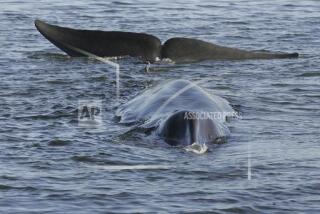World Ban on Whaling to Continue : Environment: But an International Whaling Commission compromise may lead to a lifting of the moratorium next April.
- Share via
LONDON — The International Whaling Commission, meeting in Glasgow, Scotland, reached a contentious compromise between its pro- and anti-whaling factions Friday that will continue a ban on commercial whaling through next April.
But the compromise appeared to move the IWC a step closer to a resumption of commercial whaling, banned in the world’s oceans since 1988. And it comes at a time when at least one country has already announced that it will defy the moratorium on whaling.
If the moratorium is lifted, hunting likely would be allowed on the minke whales, the smallest of the baleen whales, in the North Atlantic and Antarctic oceans.
But under the compromise, the soonest a vote can be taken on the hunting ban is next April, when the IWC meets in Japan.
IWC spokesman Greg Donovan said an “inspection and observation scheme would be developed this year” under which commercial whaling might be resumed.
“It certainly doesn’t mean that whaling would start up this year, or probably next,” he said. “But it may involve a resumption the year after.
“It will have to be agreed to at next year’s meeting.”
In the meantime, more than one country is sharpening its harpoons. Norway has said that it will resume hunting whales next year. Iceland withdrew from the IWC on Monday, and though it has not said that it will start whaling again, no one will be surprised if it does.
“That decision has not been made,” said Helgi Agustsson, Iceland’s ambassador to Britain. But he left the impression that it would not be long in coming.
Sixteen of the 28 IWC countries represented in Glasgow voted for the resolution to set up the monitoring scheme, the framework within which catch quotas would be set. Eleven abstained.
Only Norway voted against it, wanting to end the moratorium immediately.
The resolution had been advanced as a compromise by Australia, Finland, Germany, Switzerland and the United States.
Worse for the whales, the IWC’s pre-eminence in the field of whale management may be eroded by the creation of a rival bloc of whaling nations, the North Atlantic Marine Mammals Commission.
The NAMMC groups Norway, Iceland, Greenland and the Faroe islands, all traditional whaling lands. Japan, one of the countries most eager to see an end to the moratorium on commercial whaling, has been invited to attend the next meeting of NAMMC, and there are fears that it might join.
Japan is the only IWC country that has continued to take about 300 whales a year, mostly in Antarctic waters. It is allowed to do so under a provision in the original document that established the IWC.
Tokyo says it takes the whales for “scientific purposes,” but environmental organizations such as Greenpeace say the Japanese do it because whale meat fetches about $220 a pound in Tokyo restaurants.
The approved compromise uses a mathematical formula aimed at safeguarding whale stocks while allowing some commercial whaling in the Antarctic Ocean and possibly in the North Atlantic.
The minkes, which are 20 to 30 feet long, were almost wiped out in the 1960s but have since multiplied. Experts estimate that 114,000 are in the North Atlantic and about 760,000 are in the Antarctic Ocean. The average minke whale is worth about $50,000 on the commercial market.
The great whales--such as the blue, sperm and humpback--have much smaller numbers and would continue to be protected as endangered species.
More to Read
Sign up for Essential California
The most important California stories and recommendations in your inbox every morning.
You may occasionally receive promotional content from the Los Angeles Times.













